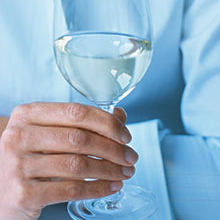Wine Etiquette and How to Serve Wine
Wine Etiquette and How to Serve Wine

How to Present and Serve Wine to Guests
Modern day wine etiquette when serving wine to friends and family draws its traditions back many many years, by knowing the background of some of these traditions you will be able to remember what you need to do when serving wine to your guests.
When you present a wine bottle to the host of the table, you are really just asking him (or her) to confirm that the wine you are serving is, in fact, the one he ordered. This is pretty basic stuff, and the tradition has changed very little over the ages. It is nice to know that there are, even in this rapidly changing world, some things that remain constant.
On the other hand, some things have really changed. When you remove the capsule from a wine bottle, you are, in fact, removing an ancient rat-proofing device. The lead originally used in these capsules would poison the rats in your cellar before the vermin could chew up the vastly more edible corks.
These days many wineries have decided to go without the capsule completely, while other use clear plastic or even a top dot of sealing wax. And the purpose, other than simply looking nice, is to provide a barrier to prevent tampering. That, as we will see later, is not an altogether modern concept.
The cork itself was originally presented to the diner to indicate that it was, in fact, from the winery itself. In the days of various bottlings in various locations, it was thought that the cork, far more than the label, was an indication of the integrity of the bottle's provenance. With most fine wines being bottled at the Chateau or winery, the issue of provenance is far less important than it was years ago. Many corks come stamped with some indication of vintage and the producer. This fact originated so that you knew the wine bottle hadn't been refilled with some imitation wine by a mischievous operator.
When you place the cork unobtrusively on the table near the host, you are merely allowing an inspection of it, if he or she desires. It is not, as some believe, to suggest to the host that he or she spend some time evaluating the quality of the cork, the number of growth rings in the bark, or the level of the moisture content. If the wine tastes good, it matters little what the cork does-and vice versa.
Perhaps the oldest of the traditions of service require that we pour the host a small taste of the wine. These days this is done to allow the host to make sure the wine is sound, and consistent with the characteristics of the wine he or she ordered. However, traditionally this was done for another purpose.
In the feudal age of lords and ladies, the host was poured first, so that he could assure his guests that he was not trying to poison them. Poisoning was quite a popular political strategy in those days, and dinner invitations from the castle next door must have been a mixed blessing.
In fact, this is also where the tradition of the sommelier arose. As the official taster for the manor or castle, the sommelier was supposed to taste each wine and make sure it wouldn't poison anyone.
Once the wine was opened the specific pouring order depended on many things-and has changed over the years, from country to country. While some may have poured the guest of honor first, and others the royal family and then guests, we have a straightforward and simple protocol: start with the personalized wine glass of the diner to the immediate left of the host, and pour around the table in a clockwise direction, finishing up with the host.
In an age when social status, position, and success were all reflected in one's position at the dinner table, these issues were of vital concern. In today's more egalitarian society, these rules have simply become a reasonable and efficient way for diners and their staff to work together towards a great dining experience. Which is to say, they still matter.



